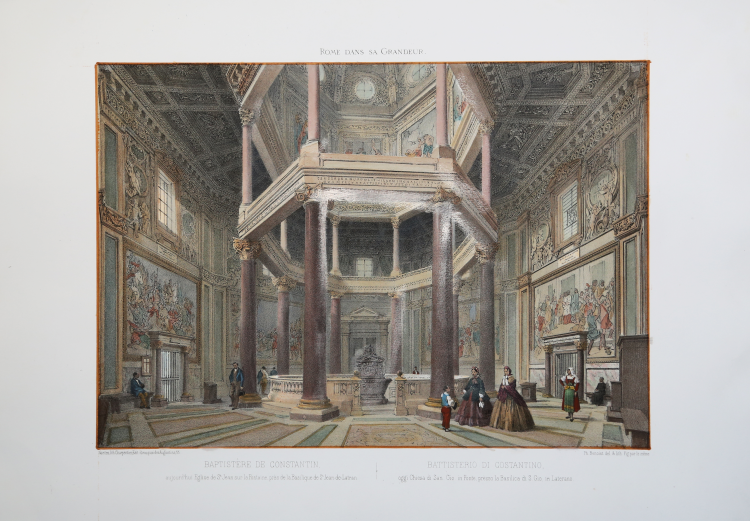



| Reference: | S36489 |
| Author | Philippe BENOIST |
| Year: | 1870 |
| Zone: | San Giovanni in Laterano |
| Printed: | Paris |
| Measures: | 500 x 350 mm |


| Reference: | S36489 |
| Author | Philippe BENOIST |
| Year: | 1870 |
| Zone: | San Giovanni in Laterano |
| Printed: | Paris |
| Measures: | 500 x 350 mm |
View taken from the monumental work of Felix Benoist Rome dans sa grandeur. Vues, monument ancient et modernes printed in Paris in 3 volumes, by Henri Charpentier, in 1870.
The publication, illustrated by 100 lithographs, was preceded by a campaign of preparatory drawings, from 1864 to 1869, executed mainly by Felix Benoist and partly by Philippe Benoist.
On the eve of the First Vatican Ecumenical Council, August 11, 1869, Pius IX decreed the creation of the Esposizione romana delle opere d’ogni arte eseguite per il culto cattolico (a Roman Exhibition of the works of art created for Catholic worship), which was inaugurated on February 17, 1870, in the cloister of the Charterhouse of Santa Maria degli Angeli. On that occasion, the three volumes in folio Rome dans sa grandeur were presented. The volumes, magnificently bound, with the coat of arms of Pius IX stamped in gold in the center, are divided into three sections. The first volume deals with ancient Rome, the second with “Christian” Rome, and the third with the monuments and achievements of modern Rome. A precious vision of papal Rome on the eve of the profound transformation of Rome into the capital of united Italy. A document that highlights the remarkable imprint left by Pius IX in the Eternal City.
The work represents the masterpiece of the French artist, where each view is made in tinted lithography, a process achieved by using a different number of stones. The result is a work of great effect, so much so as to place Benoist among the ranks of the greatest artists of interiors and views of his time.
Tinted lithograph, finely hand-colored, in excellent condition.
Philippe BENOIST (Ginevra 1813 – Parigi 1905)
|
One of France's most gifted topographical artists of the 19th century, Philippe Benoist was both a master lithographer and painter. He began his career in Paris studying and apprenticing under the most influential pioneer of early photography, Louis Daguerre. By 1836, however, Philippe Benoist had turned entirely to art and was exhibiting his views at the Paris Salons and continued to do so until1879. As an original lithographic artist, Philippe Benoist specialized in exterior and interior views of many famous buildings. These were usually published in sets, such as Monuments du Moyen Age, L'Italie Monumentale et Artistique and Vues de Paris, published in 1881. It represents one of the artist's finest undertakings as each lithograph was printed in subtle colors using a number of tint stones. Finally, the figures and some of the foreground objects were then hand-colored by commissioned artists. The end result produced by these large and elaborate lithographs, thus more than justifies Philippe Benoist's position as one of the greatest artists of interior views and monumental scenes of his time.
|
Philippe BENOIST (Ginevra 1813 – Parigi 1905)
|
One of France's most gifted topographical artists of the 19th century, Philippe Benoist was both a master lithographer and painter. He began his career in Paris studying and apprenticing under the most influential pioneer of early photography, Louis Daguerre. By 1836, however, Philippe Benoist had turned entirely to art and was exhibiting his views at the Paris Salons and continued to do so until1879. As an original lithographic artist, Philippe Benoist specialized in exterior and interior views of many famous buildings. These were usually published in sets, such as Monuments du Moyen Age, L'Italie Monumentale et Artistique and Vues de Paris, published in 1881. It represents one of the artist's finest undertakings as each lithograph was printed in subtle colors using a number of tint stones. Finally, the figures and some of the foreground objects were then hand-colored by commissioned artists. The end result produced by these large and elaborate lithographs, thus more than justifies Philippe Benoist's position as one of the greatest artists of interior views and monumental scenes of his time.
|